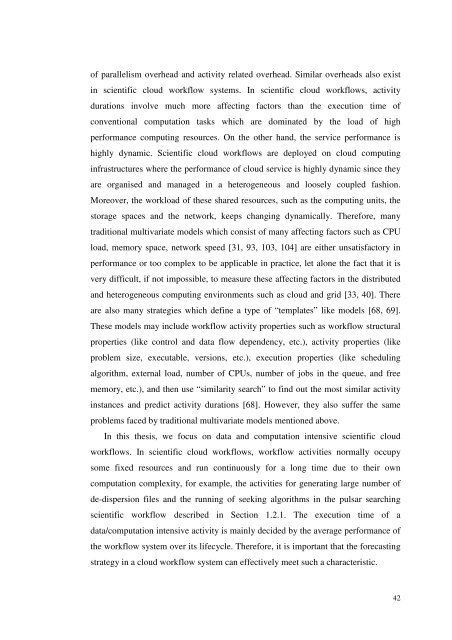Xiao Liu PhD Thesis.pdf - Faculty of Information and Communication ...
Xiao Liu PhD Thesis.pdf - Faculty of Information and Communication ...
Xiao Liu PhD Thesis.pdf - Faculty of Information and Communication ...
You also want an ePaper? Increase the reach of your titles
YUMPU automatically turns print PDFs into web optimized ePapers that Google loves.
<strong>of</strong> parallelism overhead <strong>and</strong> activity related overhead. Similar overheads also exist<br />
in scientific cloud workflow systems. In scientific cloud workflows, activity<br />
durations involve much more affecting factors than the execution time <strong>of</strong><br />
conventional computation tasks which are dominated by the load <strong>of</strong> high<br />
performance computing resources. On the other h<strong>and</strong>, the service performance is<br />
highly dynamic. Scientific cloud workflows are deployed on cloud computing<br />
infrastructures where the performance <strong>of</strong> cloud service is highly dynamic since they<br />
are organised <strong>and</strong> managed in a heterogeneous <strong>and</strong> loosely coupled fashion.<br />
Moreover, the workload <strong>of</strong> these shared resources, such as the computing units, the<br />
storage spaces <strong>and</strong> the network, keeps changing dynamically. Therefore, many<br />
traditional multivariate models which consist <strong>of</strong> many affecting factors such as CPU<br />
load, memory space, network speed [31, 93, 103, 104] are either unsatisfactory in<br />
performance or too complex to be applicable in practice, let alone the fact that it is<br />
very difficult, if not impossible, to measure these affecting factors in the distributed<br />
<strong>and</strong> heterogeneous computing environments such as cloud <strong>and</strong> grid [33, 40]. There<br />
are also many strategies which define a type <strong>of</strong> “templates” like models [68, 69].<br />
These models may include workflow activity properties such as workflow structural<br />
properties (like control <strong>and</strong> data flow dependency, etc.), activity properties (like<br />
problem size, executable, versions, etc.), execution properties (like scheduling<br />
algorithm, external load, number <strong>of</strong> CPUs, number <strong>of</strong> jobs in the queue, <strong>and</strong> free<br />
memory, etc.), <strong>and</strong> then use “similarity search” to find out the most similar activity<br />
instances <strong>and</strong> predict activity durations [68]. However, they also suffer the same<br />
problems faced by traditional multivariate models mentioned above.<br />
In this thesis, we focus on data <strong>and</strong> computation intensive scientific cloud<br />
workflows. In scientific cloud workflows, workflow activities normally occupy<br />
some fixed resources <strong>and</strong> run continuously for a long time due to their own<br />
computation complexity, for example, the activities for generating large number <strong>of</strong><br />
de-dispersion files <strong>and</strong> the running <strong>of</strong> seeking algorithms in the pulsar searching<br />
scientific workflow described in Section 1.2.1. The execution time <strong>of</strong> a<br />
data/computation intensive activity is mainly decided by the average performance <strong>of</strong><br />
the workflow system over its lifecycle. Therefore, it is important that the forecasting<br />
strategy in a cloud workflow system can effectively meet such a characteristic.<br />
42
















